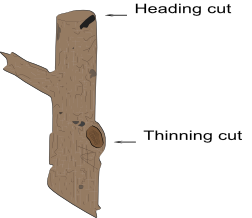It's possible that some of you may think that a lot of scare mongering is going on, with regards to trees and paying someone to work on them, or risks associated with trees are not such a factor.
Quite simply the call is yours to make. I firmly believe if you own trees they should be getting managed and not just left to grow naturally or wild (which is my preferred term).
Reductions, reducing, tipping back are all more or less the same thing. Best practice reads that this type of work shouldn't really be carried out, a person that has a tree on top of a building will think differently about best practice. There are situations when one of the above is the right thing to do.
Pollarding, see above.
Felling has to be carried out from time to time. Thoughts on this are varied good and bad.
My preference is to work on a tree that is to be retained and not have to reduce it. Carrying out a crown clean, maybe be remove a branch here and there to encourage good branch spacing. If certain limbs need to be lifted or raised, not a problem. Certain parts on a side may need attention due to a building, also not a problem.
will finish later
Friday 22 March 2013
Earth Hour
Earth Hour is here again.
Hope you all take part. If you do not know what it is heres a link http://www.earthhour.org/. There may be a local event in your area. The local link on the above URL is at the top of that page
the most important thing is to take part. Encourage as many people as you can
Saturday 16 March 2013
Three Step Cut
How To Make Pruning Cuts

- Correct PPE, Personal Protective Equipment
- Three step cut - Make an undercut several inches out from the branch attachment, make a second cut on the topside an inch further along. The branch can be snapped off from there. This removes weight and leaves the trunk to support an elongated stub. The third cut can be made just outside the branch collar (never inside the collar). Care should be taken to ensure no tears or rips occur, you can take the stub in your hand to support and gently finish off the cut.
- If a branch is dead complete it's removal in the same way.
- sometimes the dead branch has a live collar that has started to grow down the length of the dead wood. Remove the branch only up to the extended live collar. Again do not cut inside the collar.
The above picture shows the third and final cut just outside the branch collar. This is a professional cut, it minimizes the size of the cut and allows the tree to heal the wound quicker. Pruning this way only removes branch tissue and not stem tissue.
The first cut on the underside will stop stem tissue from tearing when the branch snaps away from the tree. The second cut on the topside can be partially cut through or cut straight through until the branch falls. The top cut is basically cutting through any holding wood, the bottom cut is the closest place to the trunk a cut is made to remove a branch, any wood or bark attached to the piece being removed does not want to extend beyond the first cut toward the trunk.. Only the third and final cut should be made inside the fist, once the weight of the branch has been removed.
This type of cut could also be classed as a thinning cut. A tree will be more able to retain its natural form when pruned this way rather than when carrying out heading cuts.
If you have the space to allow your tree to grow there should be no need for a heading cut, unless safety is a factor in the reasons for pruning.
Branch Bark Ridge: ridge of bark that forms in a branch crotch and partially around the stem as the growth of the stem and branch tissues press together.
Branch Collar: bulge formed at the base of a branch by annual production of overlapping layers of branch and stem tissues.
Crown Reduction: a method of pruning used to reduce the height of a tree. Branches are cut back to laterals that are at least one-third the diameter of the limb being removed.
Crown Thinning: a method of pruning to increase light penetration and air movement through the crown of a tree by selective removal of branches.
Flush Cuts: pruning cuts that are inside the branch bark ridge or the branch collar.
Included Bark:bark enclosed between branches with narrow angles of attachment,forming a wedge between the branches.
Pollarding: removal of all of the previous growth, resulting in a flush of slender shoots and branches.
Stub Cuts: third cut of the step cut made too far outside the branch bark ridge or branch collar.
Tipping : a poor maintenance practice used to control the size of tree crowns; involves the cutting of branches at right angles leaving long stubs.
Topping: a maintenance practice often used to control the size of trees; involves the indiscriminate cutting of branches and stems at right angles leaving long stubs. Topping is often wrongly referred to as pollarding.
Woundwood: produced on woody plants as a response to wounding (also known as a callus).
Subscribe to:
Posts (Atom)
